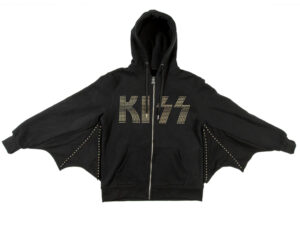intro
In 2007, two forces of creative modernity—Pharrell Williams and KAWS—merged their sensibilities in a collaboration that would quietly prefigure the shape of twenty-first-century art collecting. The project, known as The Smurfs Collection, became one of the most striking examples of how pop culture, fine art, and celebrity taste could blend into a single, visually charged, and culturally symbolic gesture. Conceived for Pharrell’s Miami apartment, the collection consisted of three large-scale paintings by KAWS that reinterpreted the beloved Belgian cartoon figures, the Smurfs, through the artist’s signature visual lexicon of “X” eyes, skull motifs, and bold color blocking.
These works—titled KURFS (CLOUD), KURFS (PAPA), and a third variant—stand as milestones in both KAWS’s artistic evolution and Pharrell’s journey as a cultural curator. At a time when contemporary art was beginning to flirt more openly with hip-hop, street culture, and fashion, the partnership signaled the rise of a new collector archetype: the artist-musician hybrid who redefined what patronage could look like in the age of pop luxury.
show
To understand the 2007 Smurfs Collection, one must first situate it in the trajectory of both collaborators. Pharrell Williams, already recognized for his work as one half of The Neptunes and as the visionary frontman of N.E.R.D, was rapidly expanding his identity beyond music into fashion, design, and art. His work with brands like Billionaire Boys Club and Ice Cream had established him as one of the first major figures to fuse streetwear with luxury. Around the same period, his collecting interests grew sophisticated—he acquired pieces by Takashi Murakami, Mark Ryden, and eventually KAWS.
KAWS, or Brian Donnelly, came from an entirely different discipline. Beginning as a graffiti artist in the early 1990s, he gained notoriety for “interventions” on bus stop ads and billboards—reworking corporate imagery with his distinctive skull and crossbones-style characters. His street-level practice evolved into a more refined art form: paintings, sculptures, and vinyl toys that translated his fascination with pop iconography into collectible objects. By 2007, KAWS had already developed a cult following in both the art world and the designer toy community.
The two artists’ meeting was therefore inevitable—a shared ethos of curiosity, irreverence, and design intelligence brought them together. Pharrell was drawn to KAWS’s hybrid style: part vandalism, part minimalism, part nostalgia. KAWS, in turn, found in Pharrell the perfect collector—someone who not only understood but actively lived within the crosscurrents of art, fashion, and sound. The Smurfs commission emerged from that synergy.
View this post on Instagram
imagine
The Smurfs, originally created by Belgian illustrator Peyo in 1958, embody an uncomplicated innocence. They live in a utopian, mushroom-shaped village, untouched by cynicism or urbanism. For KAWS, this imagery was fertile ground for reinterpretation. By 2007, he had already produced works that manipulated other pop-culture icons—SpongeBob, the Simpsons, and Mickey Mouse—through his distinctive aesthetic filter. The Smurfs, with their clean outlines and instantly recognizable blue hue, were the next logical extension of his cartoon-based vocabulary.
In The Smurfs Collection, however, KAWS made a subtle but critical change. Rather than directly naming the works after the original characters, he titled them KURFS. This linguistic shift—from “Smurf” to “Kurf”—acted as both a parody and a claim of artistic ownership. It was his way of signaling transformation: the Smurfs were no longer Peyo’s characters, but his own creatures, existing in a liminal zone between copyright and creation, innocence and irony.
The visual language of the pieces mirrored this duality. Each painting portrayed a Smurf character rendered in bold color fields, their faces flattened into graphic planes and overlaid with KAWS’s signature “X” eyes. The result was both familiar and unsettling. What once symbolized childlike joy now appeared ghostly, disembodied, even melancholic. KAWS used nostalgia not as comfort but as critique—revealing the hollow repetition of cultural icons in a world obsessed with mass production and branding.
pharrell
Pharrell’s Miami apartment became the natural habitat for these works. Far from being hidden in a private collection or gallery, the paintings were installed prominently within his home, integrated into the interior architecture as living art. In photographs from the period, KAWS’s blue-hued KURFS canvases stretch along the walls of a minimalist hallway, their electric tones bouncing off polished surfaces and sunlight.
The placement was intentional. For Pharrell, art was not an accessory but an extension of his identity—a reflection of his mind’s rhythm. His Miami space became a visual diary, containing pieces from multiple disciplines: Murakami’s exuberant flowers, Ryden’s surreal narratives, and KAWS’s hybrid pop deconstructions. The apartment was less a dwelling and more a conceptual environment—one that mirrored Pharrell’s approach to creative production itself: modular, interdisciplinary, and unafraid of contradiction.
By hanging the Smurfs Collection there, Pharrell helped to redefine art’s role in contemporary living. The traditional white cube of the gallery gave way to the “luxury laboratory” of the home. This shift anticipated the cultural landscape of the following decade, when art collecting would increasingly merge with interior architecture, and the line between lifestyle and artistic patronage would blur almost entirely.
flow
From a formal standpoint, the Smurfs Collection exemplifies KAWS’s balance between cartoon clarity and painterly discipline. Each piece maintains the crispness of a graphic illustration yet reveals subtle evidence of handwork—brush textures, paint density, controlled imperfection. The color palette draws heavily from the Smurf lexicon: blues, whites, blacks, and hints of red. However, KAWS’s compositional sense is less about literal representation and more about emotional architecture. The characters are cropped, abstracted, or partially dissolved within the canvas.
This abstraction transforms the Smurfs into shapes and emotions rather than narratives. The works pulse with a static energy—a tension between the image we think we know and the one we’re being forced to confront anew. KAWS’s genius lies in this distortion. By slightly misaligning the proportions of the characters, he invites us to feel the uncanny. What was once playful now seems melancholic; what was once background now becomes the subject.
The “X” eyes, his most recognizable motif, serve as a unifying device. In the context of the Smurfs, they act as both aesthetic and emotional punctuation. The “X” simultaneously suggests death, anonymity, and defiance. In graphic terms, it flattens the face, reducing the character’s individuality to pure symbol. In philosophical terms, it comments on how media culture erases specificity in favor of recognizability—how a character can be both universal and empty at the same time.
the symbol
The Smurfs Collection for Pharrell is not just an aesthetic object—it’s an act of cultural synthesis. It bridges three seemingly disparate domains: street art, high design, and celebrity culture.
For KAWS, collaborating with Pharrell represented entry into a new class of patronage—one driven not by museums but by musicians, fashion designers, and creative polymaths. This was no accident. Both men understood that the early 2000s marked the rise of what might be called “cultural capital flow,” where influence was no longer linear (from art to pop culture) but cyclical. Art influenced fashion; fashion influenced music; music influenced art again. The KAWS–Pharrell collaboration exemplified that loop.
For Pharrell, commissioning KAWS was a declaration of aesthetic independence. It said: this is not art chosen by a curator or gallerist; this is art chosen by someone who lives it. It aligned him with a new generation of collectors—figures like Kanye West, Swizz Beatz, and later A$AP Rocky—who built personal collections not around academic taste but around resonance, emotion, and cultural recognition. The Smurfs paintings, with their mix of irony and sincerity, captured exactly that spirit.
emotion
Beyond their visual surface, the Smurfs Collection carries emotional weight. The Smurfs, once emblems of pure fantasy, here appear muted and ambiguous. Their faces, though familiar, seem drained of expression. KAWS’s use of flat color and contour recalls both mid-century animation and contemporary branding—yet within the flatness lies a quiet melancholy.
This emotional tension reflects the artist’s own evolution. KAWS often describes his work as an exploration of loneliness, memory, and identity beneath the surface of consumer culture. By painting childhood icons stripped of context, he reveals the fragile nostalgia that underpins much of modern desire. The Smurfs, in this form, become meditations on the loss of innocence—a commentary on how childhood symbols are continually repackaged for adult consumption.
At the same time, the paintings retain humor and vitality. The tension between joy and nihilism, brightness and void, is central to KAWS’s aesthetic. It’s also why Pharrell—whose own music often oscillates between optimism and introspection—found such resonance in the work. Both artists operate within the paradox of light and shadow, of surface pleasure concealing deeper self-awareness.
legacy
The Smurfs Collection marked a pivotal moment not only in KAWS’s career but also in the broader art world’s relationship with pop culture. After 2007, KAWS’s market value and visibility soared. His large-scale paintings began to appear in major collections, and collaborations with brands like Dior, Uniqlo, and Jordan followed. The blueprint established in Pharrell’s apartment—a dialogue between art, commerce, and celebrity—became the model for a generation of artists who blurred boundaries as a matter of principle.
Pharrell, too, deepened his engagement with art, going on to co-curate exhibitions, launch collaborative design projects, and eventually helm Louis Vuitton’s menswear division. His early investment in artists like KAWS helped to normalize the idea of musicians as serious patrons, capable of shaping visual culture as much as musical trends.
In retrospect, The Smurfs Collection feels prophetic. It anticipated the “hype art” ecosystem that would dominate the 2010s and 2020s—a world where limited-edition collectibles, pop iconography, and street art aesthetics became part of mainstream art commerce. But unlike the mass-market editions that followed, the 2007 collection retains intimacy and intent. It wasn’t created to sell merchandise; it was created to articulate a shared worldview.
collect
Though physically confined to Pharrell’s personal space, The Smurfs Collection has since acquired mythic status among fans of both artists. It’s frequently cited in retrospectives and museum catalogs as a key early example of KAWS’s cartoon-based paintings on a monumental scale. When KAWS’s retrospective opened years later at the Brooklyn Museum, echoes of the KURFS could be felt in newer works—proof that these 2007 paintings were more than a footnote; they were a foundation.
The collection also cemented the visual dialogue between music and art that defines so much of today’s cultural landscape. In an era when Travis Scott curates museum installations, or when artists like Tyler, the Creator design stage sets influenced by mid-century painting, one can trace the lineage back to moments like this—where art entered the musician’s home, not as décor but as philosophy.
evolve
It’s worth noting how The Smurfs Collection sits in aesthetic continuity with KAWS’s later series. The flat colors, cropped faces, and layered graphics reappear in his Spongebob paintings (2008–2009) and The Kimpsons series (2011). The emotional detachment that defines the Smurf faces evolves into the haunting gaze of the Companion sculptures. In that sense, the Pharrell commission operates as both prototype and manifesto.
Formally, the paintings also demonstrate KAWS’s dialogue with modernist composition. Beneath the cartoon surface, one detects echoes of Ellsworth Kelly’s color fields, Lichtenstein’s comic abstraction, and even Matisse’s spatial balance. Yet the emotional register remains distinctly twenty-first century—a kind of post-digital melancholy, where the image has been overexposed to repetition and now exists only as residue.
impression
The Smurfs Collection by KAWS for Pharrell Williams stands as a landmark in contemporary visual culture—a meeting point where nostalgia, celebrity, and postmodern critique converge. It encapsulates the early 2000s moment when street art stepped confidently into the high-art conversation and when collectors like Pharrell began redefining cultural taste through lived experience rather than academic endorsement.
The three KURFS paintings—haunting, playful, and deeply self-aware—remain among KAWS’s most emblematic works. They distill his fascination with memory, his negotiation between irony and sincerity, and his ability to turn mass imagery into meditative form. For Pharrell, they represent not just decoration but declaration: art as lifestyle, lifestyle as art.
Nearly two decades later, the collaboration continues to echo across creative disciplines. Whether through KAWS’s monumental sculptures or Pharrell’s leadership at Louis Vuitton, the spirit of The Smurfs Collection endures—a blueprint for how two creative minds, united by curiosity and cultural fluency, can transform the symbols of childhood into the icons of a new artistic age.
No comments yet.








